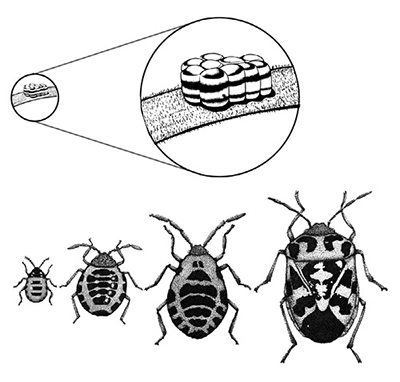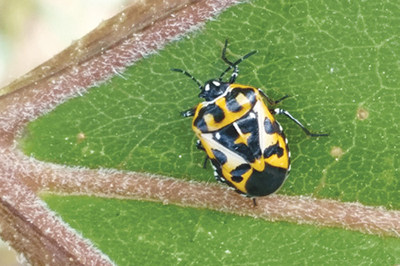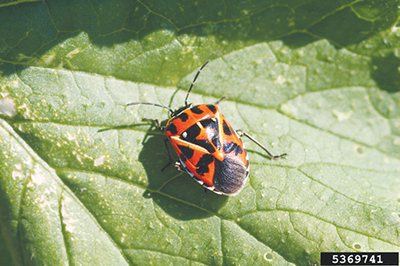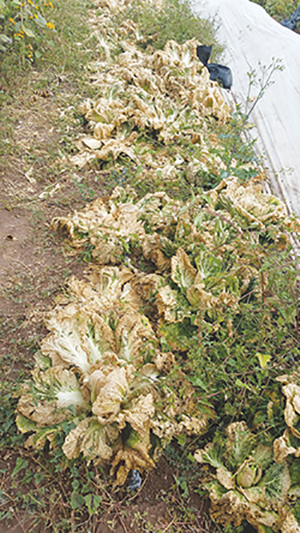Guide H-259
J. Breen Pierce
College of Agricultural, Consumer and Environmental Sciences, New Mexico State University
Author: Extension Entomologist, Department of Extension Plant Sciences, New Mexico State University. (Print Friendly PDF)
Description
Harlequin bug (Murgantia histrionica) is entomologically a “true” bug—an insect in the Hemiptera order, which also includes stink bugs and leaf footed bugs. Many people incorrectly refer to them as beetles, but beetles have a hard, protective covering or elytra that completely covers their abdomen. Hemipteran insects have hemelytra that cover only the upper abdomen. Hemipterans also have incomplete metamorphosis (egg, nymph, and adult stages; Figure 1), while beetles have complete metamorphosis (egg, larva, pupa, and adult stages). The presence of nymphs, which look similar to adults rather than larvae, indicates that these insects are not beetles.

Figure 1. Harlequin bug development: eggs (top), nymphs (bottom left), and adult (bottom right). (Illustration by Darren Huff, New Mexico State University.)
Harlequin bug originated in Mexico and Central America but was first reported in the United States in Texas in 1864. It is considered a common pest in the southern United States but is becoming increasingly common in more northern states such as Pennsylvania, where harlequin bug was recently reported as a pest. Adults are 1/4- to 3/8-inch-long, shield-shaped insects with broad shoulders. Adults and nymphs are vividly colored with deep blue or black and bright orange or red (Figures 2 and 3). Nymphs’ coloration is similar to adults but without wings. Eggs are barrel-shaped and encircled with dark rings, with a dark crescent on top against a white background. The eggs are set on end generally in two rows of six on the undersides of leaves.

Figure 2. Harlequin bug adult with subtle feeding damage. (Photo by Patricia Monk, New Mexico State University.)

Figure 3. Harlequin bug adult with significant feeding damage. (Photo by Whitney Cranshaw, Colorado State University, Bugwood.org.)
Biology
Harlequin bug completes two to three generations in the southern states, with five to six immature nymphal stages. Development time is 30–50 days from egg to adult depending on temperature (Canerday, 1965). Under laboratory conditions, males and females live 68 and 82 days, respectively (Streams and Pimentel, 1963).
In the field, adult males may live up to 25 days, while females often live 48 days but can live up to 80 days (Streams and Pimentel, 1963). Females mate throughout their lives and lay a mass of about 12 eggs every three days, or up to 164 eggs per female.
Harlequin bugs are often found clustered together rather than randomly dispersed throughout a field. In fact, females often remain on or near the first plant they fed on as a newly hatched nymph (English-Loeb and Collier, 1987). Adults produce aggregation pheromones that cause them to congregate. In addition, preferences for favorite host plants will also lead to aggregation on those host plants. Their behavior to aggregate can be useful since it makes trap cropping a possibility for management.
Adults overwinter under crop residue. Winter temperatures reduce survival of this subtropical native, particularly in areas with cold winters. They can overwinter as far north as Pennsylvania, but survival is typically low. In the higher elevations of New Mexico, overwintered survival is likely low in habitats where there is little insulation. They become active again in early spring, feeding on cruciferous plants such as mustard and radish. By summer, populations have increased to the point where they can be serious pests of vegetable crops and some fruit crops.
Host Plants
Harlequin bugs prefer feeding on plants in the Brassicaceae family, also known as the mustard family or crucifers. This includes 3,700 species in 338 genera. Any plants in this family should be assumed to be attractive, but harlequin bugs will also accept and feed on some plants outside this family. Favored host plants include mustards, turnips, and Chinese cabbage. Other preferred host plants include broccoli, cauliflower, radishes, and collards. Other crops are also affected, particularly when the bugs’ preferred host plants are not available; these include asparagus, beans, cantaloupe, onion, pea, potato, squash, and tomato. Harlequin bug also feeds on some fruits, including grape, peach, pear, and raspberry.
Plant Damage
Like other true bugs, the harlequin bug damages plants by inserting its beak-like mouthpart into plant tissue and sucking out fluids, which destroys plant tissue and potentially kills plants, particularly young plants. Damage appears as stippling or light-colored cloudy spots. Young plants will have larger areas of plant tissue with dead patches, wilting, deformed growth, and possibly plant death (Figure 4).

Figure 4. Harlequin bug damage.
Cultural Control
Cultural control measures should focus on sanitary efforts, particularly removal of crop debris in the fall or early winter to reduce overwintering populations. Each bug that survives the winter can, along with its progeny, ultimately produce thousands of bugs the following summer. Exposure to cold temperatures should kill most overwintering harlequin bugs in higher elevations of New Mexico, but insulation with vegetation can reduce exposure and thus reduce mortality.
The most effective time to control harlequin bug is in the fall and early spring when you have help from low temperatures and an absence of host plants. Early spring harlequin bugs may feed on wild mustards, so controlling these weeds can have a dramatic impact and suppress populations that could otherwise become overwhelming by midsummer. The impact may seem slight, but each female can produce 164 offspring. Without any control measures, her 82 female offspring can produce over 13,000 offspring in the second generation, and so on.
Control in the fall is most easily achieved by cleaning up crop residue by removing or plowing under the ground. This prevents adults from overwintering successfully by exposing them to lethal temperatures.
Trap Crops
Like blister beetles in alfalfa hay, harlequin bug produces an aggregation pheromone that causes them to cluster in one area of a field. This characteristic and their strong preference for some Brassica crops makes the use of trap crops particularly appealing. Research to determine the methods for trap crop timing and placement is still in progress (Wallingford et al., 2013). However, for organic growers and small gardeners who are interested in minimizing insecticide applications, trap cropping might be a useful option.
Trap crops for harlequin bugs could be used in both the fall and in the spring, but spring is preferable. To use a trap crop in the fall, leave a late-planted area of a Brassica where adults will congregate, then apply a control strategy such as mowing or an insecticide to suppress adults. In the spring, very early plantings can be used to attract and control overwintered adults. Kale in the fall and mustard or radishes in the spring can be used as trap crops. Cleome spp., a favorite of harlequin bug, can also be used as a trap crop.
If the area infested is not a small garden, then trap crop plants should be disbursed throughout the field. Trap crops must be managed intensively. The danger of using a trap crop is that if harlequin bugs are not removed diligently and routinely you could increase the population of these pests.
Biological and Chemical Control
Biological control options are limited. However, three species of parasitic wasps can provide 8–50% control. If control from parasitoids is combined with significant predation of adults and nymphs, biological control could be a reliable source of pest suppression. Unfortunately, harlequin bugs have good predator defenses, as you might suspect from its bright colors. Like other brightly colored insects, harlequin bugs produce chemical defenses by sequestering chemicals from their host plants. The sequestered chemicals are distasteful to predators, who quickly learn to leave this particular pest alone, which offers protection from predation. Predation is not a reliable source of control of nymphs or adults (Howard, 1895), although there have been reports of some predation on early instars by predaceous stink bugs and praying mantis. There is likely significant predation of harlequin bug eggs in New Mexico. If predation levels are similar to those of other insect eggs, 40–80% mortality would be expected, but this has not been tested (Pierce and Monk, 2011). The most important egg predators identified in field crops include ladybugs, green lacewings, nabids, minute pirate bugs, big eyed bugs, Collops spp., hooded beetles, crab spiders, and ants (Pierce et al., 2017).
Neonicotinoids are frequently used, particularly for traps crops, since soil applications provide effective control with residual activity up to 30 days after application (Kuhar and Doughty, 2009; Wallingford, 2012). In general, insecticides are much more effective against harlequin bug nymphs than adults. If insecticides are used on the trap crop, it is preferable to mow, trim, or otherwise keep the trap crop from flowering to avoid mortality of beneficials searching for pollen or nectar sources.
Organic Grower Control Options
Options for organic growers include trap crops, discussed above, and crop residue destruction. Weed control, particularly in early spring, will help prevent early season buildup of populations. Target weeds include wild mustards, pigweed, and lambsquarters. Control of early season weeds is desirable for numerous reasons, and this is one more reason to focus on early season control. Biological control options are limited, but providing nectar sources for parasitoids and predators is always a good strategy for organic growers. Providing mulch has been shown to increase spider predation in broccoli and reduce damage from 93% to 32% (Riechert and Bishop, 1990). This is also worth considering since crab and wolf spiders are an important source of egg predation in many crops in New Mexico (Pierce et al., 2016). Insecticidal options are limited, but laboratory trials suggest that spinosad will likely produce better control than pyrethrins (Overall, 2008).
References
Canerday, T.D. 1965. On the biology of the harlequin bug, Murgantia histrionica (Hemiptera: Pentatomidae). Annals of the Entomological Society of America, 58, 931–932.
English-Loeb, G.M., and B.D. Collier. 1987. Nonmigratory movement of adult harlequin bugs Murgantia histrionica (Hemiptera: Pentatomidae) as affected by sex, age and host plant quality. The American Midland Naturalist, 118, 189–197.
Howard, L.O. 1895. The harlequin cabbage bug, or calico back (Murgantia histrionica Hahn) [Circular no. 10, second series]. Washington, D.C.: United States Department of Agriculture, Division of Entomology.
Kuhar, T.P., and H. Doughty. 2009. Evaluation of soil and foliar insecticide treatments for the control of foliar insect pests in cabbage in Virginia, 2008. Arthropod Management Tests, 34, E7.
Overall, L.M. 2008. Evaluation of organic insecticides to control harlequin bug, Murgantia histrionica (Hahn), and yellowmargined leaf beetle Microtheca ochroloma Stål, on leafy greens [M.S. thesis]. Stillwater: Oklahoma State University.
Pierce, J.B., and P. Monk. 2011. Influence of alfalfa hay on egg predation in adjacent cotton fields in New Mexico. In National Cotton Council of America (Ed.), Proceedings, 65th Beltwide Cotton Conferences, Atlanta, GA (pp. 955–980).
Pierce, J.B., P. Monk, and O.J. Idowu. 2017. Predation of sentinel eggs in cotton and sorghum in New Mexico. In National Cotton Council of America (Ed.), Proceedings, 71st Beltwide Cotton Conferences, Dallas, TX (pp. 536–541).
Pierce, J.B., P. Monk, D. Richman, and O.J. Idowu. 2016. Control of insect pests in glandless cotton: The role of biological control in New Mexico. In National Cotton Council of America (Ed.), Proceedings, 70th Beltwide Cotton Conferences, New Orleans, LA (pp. 198–201).
Riechert, S.E., and L. Bishop. 1990. Prey control by an assemblage of generalist predators: Spiders in garden test systems. Ecology, 71, 1441–1450.
Streams, F.A., and D. Pimentel. 1963. Biology of the harlequin bug, Murgantia histrionica. Journal of Economic Entomology, 56, 108–109.
Wallingford, A.K. 2012. Investigating host plant selection of harlequin bug, Murgantia histrionica (Hahn), in order to improve a trap cropping system for its management [Ph.D. dissertation]. Blacksburg: Virginia Polytechnic Institute and State University.
Wallingford, A.K., T.P. Kurhar, D.G. Pfeiffer, D.B. Tholl, J.H. Freeman, H.B. Doughty, and P.B. Schultz. 2013. Host plant preference of harlequin bug (Hemiptera: Pentatomidae), and evaluation of a trap cropping strategy for its control in collard. Journal of Economic Entomology, 106, 283–288.
For further reading
H-168: Selection and Use of Insecticides for Organic Production
https://pubs.nmsu.edu/_h/H168/
H-169: Using Insectary Plants to Attract and Sustain Beneficial Insects for Biological Pest Control
https://pubs.nmsu.edu/_h/H169/
CR-655: Integrated Pest Management (IPM) for Home Gardeners
https://pubs.nmsu.edu/_circulars/CR655/

J. Breen Pierce is a research and Extension entomologist at the NMSU Agricultural Science Center in Artesia. Her program focuses on integrated pest management of insect pests of alfalfa, pecan, and cotton, including biological control of alfalfa weevil and pecan nut casebearer, development of economic thresholds, and variation in plant resistance.
To find more resources for your business, home, or family, visit the College of Agricultural, Consumer and Environmental Sciences on the World Wide Web at pubs.nmsu.edu
Contents of publications may be freely reproduced for educational purposes. All other rights reserved. For permission to use publications for other purposes, contact pubs@nmsu.edu or the authors listed on the publication.
New Mexico State University is an equal opportunity/affirmative action employer and educator. NMSU and the U.S. Department of Agriculture cooperating.
August 2018 Las Cruces, NM


